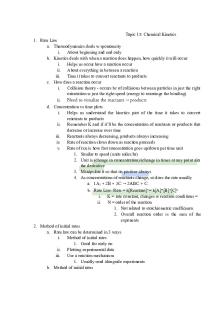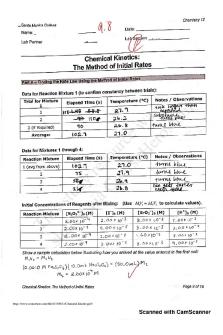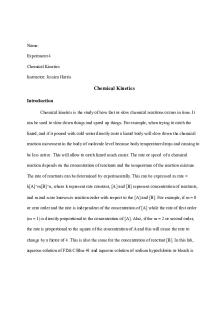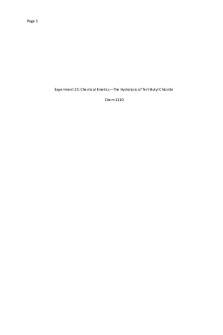Experiment 21 Chemical Kinetics - The Hydrolysis of Tert-Butyl Chloride PDF

| Title | Experiment 21 Chemical Kinetics - The Hydrolysis of Tert-Butyl Chloride |
|---|---|
| Author | Yeny Gomez |
| Course | General Chemistry II |
| Institution | California State University Los Angeles |
| Pages | 8 |
| File Size | 314.2 KB |
| File Type | |
| Total Downloads | 65 |
| Total Views | 145 |
Summary
General Chemistry 1110...
Description
Page 1
Experiment 21: Chemical Kinetics—The Hydrolysis of Tert-Butyl Chloride Chem 1110
Page 2 PURPOSE To determine the rate law of a hydrolysis reaction which will be the rate law of an organic compound in a 50% by mass isopropanol/water mixture then compose a graph of ln ( n RCl ) vs .time
which is expected
to be a linear graph. THEORY In the study of chemical kinetics, the rates of chemical reactions can be determined experimentally and theoretically. The reaction rate can be affected by certain factors such as the addition of catalysts, concentration of reactants, physical states of reactants, and temperature such as in the reaction of the hydrolysis of tert-butyl chloride in this experiment. One method of studying chemical kinetics is by utilizing titrations to observe the chemical analysis of the reaction. The rate law is by definition a mathematical expression that defines how fast reactants are converted to products. The general reaction:
aA +bB → cC+dD The rate change for the rate of this reaction can be expressed in terms of the rate of change in the concentration of reactants or rate of change in the concentration of the products. The numerical sign of the reactants will be negative, and the numerical sign of the products will be positive. This means that their concentrations will decrease at the same rate as the reaction will move forward. By understanding this concept, it can be determined that the reaction can be written as:
reactionrate=
−1 d [ A ] −1 d [ B ] 1 d [ C ] 1 d [ D] = = = a dt b dt c dt d dt
The reactants are negative because when a reaction takes place, the reactants decrease to make products. The rate law is an equation that describes the relationship between the concentration of the reactants and the rate of the reaction:
reactionrate=k [ A] x [ B ] y [C ] z [ D ]q The rate constant is the “k” in the reaction rate equation. Each exponent describes the order of the reaction for the concentration of each reactant. The overall rate order can be obtained by adding the exponents. In
Page 3 order to interpret that rate of a reaction there needs to be a reaction mechanism which helps chemists understand how reactions occur at the molecular level. In this experiment we will determine the rate law for the reaction of an organic compound with water: a hydrolysis reaction. In aqueous solution, tert-butyl chloride,
(C H 3 )3 C−Cl
reacts with water to yield tert-butyl alcohol,
(C H 3 )3 C−OH .
(Goldwhite 64). This reaction is given by the below image:
The reaction mechanism for this displacement reaction is made up of two steps. The first step which is expected to be the slow, rate-determining step will be:
The second step will be a fast reaction of the positive cation (produced from the first step) with water to produce alcohol and an aqueous proton:
When these two reactions are summed, the overall net equation of the reaction is obtained. (C H 3 )3 C
will be described as RCl
from here on forward. The rate law: ( Eq .3 ) rate=
−d [ RCl ] =kRCl dt
comes directly from the rate determining step. It is important to note that the rate law for the overall reaction is always determined by the rate law of the rate determining step. The rate law can only be determined from these reaction mechanisms.
RCl
in the rate law equation is the molar concentration
Page 4 of the tert-butyl chloride and as previously mentioned, “ k” is the rate constant.
We know from the molarity equation that molarity equals moles of solute over liters of solution, therefore
[ RCl ] in the rate law equation equals moles of RCl over liters of solution, given by:
( Eq . 4 )
( )
( )
d n RCl 1 1 =k nRCl dt V V
The factor of
( V1 )
can be factored out from the equation because we know that the solution’s volume
remains constant. The rate law becomes:
( Eq .5 )
d nRCl =k nRCl or dt
d n RCl =−kdt n RCl
By recognizing the difference between initial moles of ° RCl time,
and moles of
RCl
at some later
( Eq .5 ) can be integrated as follows to become ( Eq .6 ) n Rcl
t d n Rcl n =−k ∫ dt=ln 0Rcl =−kt ( Eq .6 ) ∫ nRCl n Rcl 0 n 0 Rcl
This can further be rearranged to obtain:
( Eq .7 ) ln ( nRCl )−ln ( n0Rcl) =−kt or
ln ( n RCl )=−kt +ln ( n0Rcl ) Equation 7 is the equation of a line. This equation directly predicts that a graph of ln ( n RCl ) time will be a linear graph with a negative slope.
versus
Page 5 EXPERIMENTAL PROCEDURES Goldwhite, H.; Tikkanen, W.; Kubo-Anderson, V.; Mathias, E. Experiments in general chemistry, Fifth ed.; Macmillan learning curriculum solutions; Plymouth, MI, 2018; 129-134. Modifications: recorded 5 readings instead of 17 due to time limit
DATA Final Temperature of Solution
23.9 ℃
Time of Color
Buret reading
Disappearance 0 437 521 729 937 1183
L (NaOH) 0 0.002 0.003 0.004 0.005 0.006
Moles of (OH)
Moles (RCl)
n ° RCl−nOH 5.35 × 10−3 −3 5.1 × 10 4.9 ×10−3 −3 4.6 × 10 −3 4.4 × 10
0 −4
5.0 ×10 −4 7.5 ×10 1.0 ×10−3 −3 1.3 ×10 −3 1.5 ×10
Ln(nRCL)
0 −5.22 −5.268 −5.32 −5.38 −5.426
RESULTS
Moles of NaOH= ( 0.25 M NaOH )( 0.002 L NaOH )=5.0 ×10−4 Moles of ° RCl=( final buret reading ) ( 0.25 M RCl ) =( 2.34 ×10−2 L ) ( 0.25 M RCl )=5.85 ×10−3 mol ° RCl Sample Calculation for −3
moles of RCl , Trial 1 −4
−3
−¿ =5.85 × 10 mol ° RCl−5.0 ×10 =5.35 ×10 moles RCl ¿ nRCl=n ° RCl−n OH
Page 6
ln(nRCl) vs. Time (sec) 0
0
1
2
3
4
5
6
7
-1
ln(RCl)
-2 f(x) = − 0.79 x − 1.67 -3
-4
-5
-6
TIme (sec) DISCUSSION In this experiment, the rate constant was obtained by first finding the moles of NaOH in order to get the moles of RCl. From there, the moles of RCl were obtained for each of the 5 trials. We were able to determine with certainty that this reaction was a first order reaction by looking at the plotted graph of
ln (RCl) versus time in units of seconds. The slope of the best fit line was -0.003. The rate constant “k” is a positive value which is also the slope of the line
0.0003 sec−1 .
DISCUSSION QUESTIONS 1. After obtaining the “k” constant, we were able to obtain the half-life of the first order reaction.
The half-life was calculated by doing the following calculation: t 1 = 2
ln (2) =2.3 × 103 sec . 0.0003
2. The time that would have been required to hydrolyze 95%of the tert-butyl chloride if no water had been added or no heating done was calculated by using the first-order integrated rate law
Page 7
ln ( RCl )=−kt+ln(RCl)
and plugging in the rate constant from discussion question 1. When
solved for “t” this equation becomes:
ln t=
([[ ]] ) ( [ RCl t
RCl −k
0
ln
=
0.05 (RCL) ] 0
[ RCL]0
−0.0003 sec
3. If the predicted rate law was
−1
)
=9.99 ×102 sec
d [ RCl] =k [RCl ][ H 2 O ] under a different mechanism, we dt
would not be able to distinguish between this mechanism proposed because it is a first order rate law as well and there would be a large amount of water. What this means is that if the mechanism provided form the lab manual had water; the concentration of the water is a lot. We know water is a solvent so we would not be able to see the difference of the water concentration from the reaction, therefor we would not be able to distinguish the difference between the 2 mechanisms. 4. Factors that could affect the accuracy or precision of the determination of the rate constant “ k” in this experiment a. The true molarity of the NaOH is different from that given on the bottle: if this were so, this would mean that the values we obtained would be precise but not accurate. In general chemistry part 1, we learned that when a target is precise, it doesn’t necessarily mean that it is accurate, therefore skewing the results of our data. b. The tert-butyl chloride contains several percent tert-butyl alcohol as an impurity: the molarity of the tert-butyl chloride would be different, therefore affecting our rate constant. The rate constant is directly proportional to the rate of the reaction so the rate of the reaction would also be affected. c. If during the experiment, the temperature changed by several degrees: this would affect the experiment because we were asked to keep the stopper on the flask right away and if did not do that, the room temperature would affect the mixture. The rate constant is
Page 8 greatly affected by temperature so if it got hotter, the reaction would speed up because of more collisions of the molecules but if it got colder, the reaction would slow down. d. If the flask is uncorked while the tert-butyl chloride solution is being heated to complete the reaction, so that some of the tert-butyl chloride is lost by evaporation, this would affect the results we obtained for the rate constant. They would probably be precise but not accurate. CONCLUSION In this experiment we were able to determine the rate constant and prove that the first integrated rate law equation provides a straight line with a negative slope based on our experimental data. We used a a large beaker half-full of distilled water and heated that up to about 40 ℃ . By adding the warm water to the solution, it helped speed up the reaction and fully react all the
RCl . We titrated NaOH (sodium
chloride) and recorded the temperature and the time during each reaction (color change). The phenolphthalein was used to indicate when the solution was acidic or basic. When we saw the solution turned a pink color, then we knew that meant the solution was basic, and if turned clear again, that meant the solution was acidic. The amounts of NaOH added helped to calculate the moles of NaOH and moles of RCl. We then plotted the data for the first order reaction and created a graph of ln (RCl) versus time. We were able to directly obtain our k value from the graph’s linear slope. REFERENCES
Goldwhite, H.; Tikkanen, W.; Kubo-Anderson, V.; Mathias, E. Experiments in general chemistry, Fifth ed.; Macmillan learning curriculum solutions; Plymouth, MI, 2018; 129134....
Similar Free PDFs

Hydrolysis of t-Butyl Chloride
- 13 Pages

Topic 15 Chemical Kinetics
- 5 Pages

Chemical Kinetics lab
- 9 Pages

Chapter 14- Chemical Kinetics
- 3 Pages

Chemical Kinetics-DR. ASM
- 44 Pages

Chemical Kinetics - lab report
- 4 Pages

Reactions Kinetics Experiment 2
- 11 Pages

Lab 11 Chemical Kinetics Report
- 4 Pages
Popular Institutions
- Tinajero National High School - Annex
- Politeknik Caltex Riau
- Yokohama City University
- SGT University
- University of Al-Qadisiyah
- Divine Word College of Vigan
- Techniek College Rotterdam
- Universidade de Santiago
- Universiti Teknologi MARA Cawangan Johor Kampus Pasir Gudang
- Poltekkes Kemenkes Yogyakarta
- Baguio City National High School
- Colegio san marcos
- preparatoria uno
- Centro de Bachillerato Tecnológico Industrial y de Servicios No. 107
- Dalian Maritime University
- Quang Trung Secondary School
- Colegio Tecnológico en Informática
- Corporación Regional de Educación Superior
- Grupo CEDVA
- Dar Al Uloom University
- Centro de Estudios Preuniversitarios de la Universidad Nacional de Ingeniería
- 上智大学
- Aakash International School, Nuna Majara
- San Felipe Neri Catholic School
- Kang Chiao International School - New Taipei City
- Misamis Occidental National High School
- Institución Educativa Escuela Normal Juan Ladrilleros
- Kolehiyo ng Pantukan
- Batanes State College
- Instituto Continental
- Sekolah Menengah Kejuruan Kesehatan Kaltara (Tarakan)
- Colegio de La Inmaculada Concepcion - Cebu







